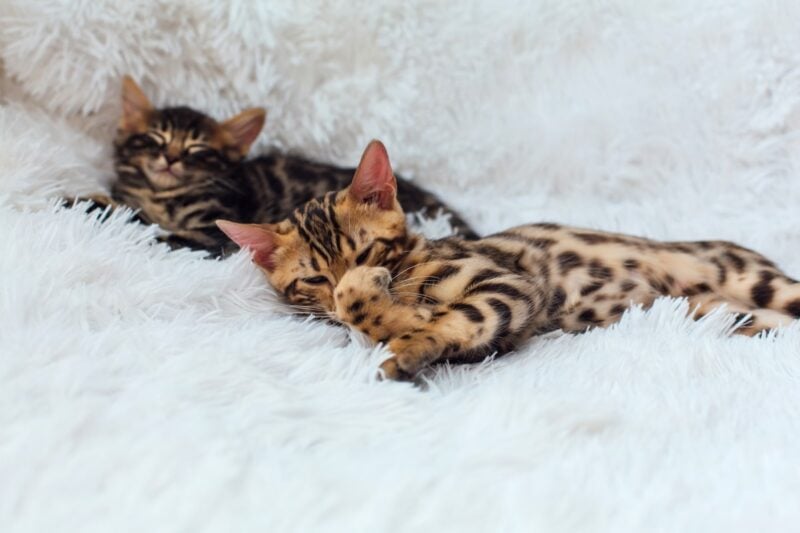True Physique Of A Maine Coon: What Their Shape Tells You

When people imagine Maine Coons, the first thing that usually comes to mind is size. These cats are often called “gentle giants” because they are one of the largest domesticated cat breeds in the world.
But their body shape is about more than bulk; it is a distinctive blueprint that reveals their evolution, natural adaptations, and health.
Recognizing the unique features of a Maine Coon’s body can help owners better understand their cat, monitor development, and spot any warning signs of illness or weight issues early.
The Rectangular Frame
The Maine Coon’s body is described as rectangular in official breed standards. This means that, when viewed from the side, their torso runs straight from shoulder to hip without the narrowing “waistline” seen in many other breeds.
Their chest is broad and deep, housing powerful lungs and a large heart – features that would have helped them survive in colder, harsher climates where stamina was key.
The back is level, and the overall impression is one of length and balance, not a compact or cobby shape.
This rectangular frame is not the result of fat but of solid muscle and strong bone. It gives Maine Coons their distinctive presence:
- Powerful
- Sturdy
- Elegant
Size And Proportions
Maine Coons are significantly larger than most domestic cats, but their growth is slow and steady.
Unlike many breeds that reach full maturity at one year, Maine Coons can take three to five years to develop their frame fully.
- Males usually weigh between 18-22 lbs (8.2-10 kg), though exceptionally large individuals can exceed this.
- Females are typically lighter, averaging 12-15 lbs (5.4-6.8 kg).
- At the shoulder, they stand about 10-16 inches (25-40 cm) tall.
- From nose to base of the tail, their body length may range from 18 to 40 inches (46-101 cm).
- Their tails are long and bushy, often measuring nearly the same length as their body, which adds balance and insulation.
This extended development period means a young Maine Coon may look lanky for a while, but over time, their frame fills out with dense muscle.
Defining Features Of The Body Shape
Several physical traits combine to give Maine Coons their unmistakable silhouette:
1. Legs And Paws
Their legs are long but in proportion to their rectangular body, with the hind legs slightly longer than the front. This creates a subtle upward slope from shoulders to hips.
The paws are large, round, and often tufted with fur, which is thought to help them walk on snow.
2. Head And Muzzle
The head is medium in size compared to the body, with high cheekbones and a square muzzle. This strong jaw gives them a slightly “lion-like” appearance and makes them excellent hunters.
3. Ears And Tufts
Their ears are tall, wide at the base, and taper to pointed tips. Many Maine Coons have lynx-like tufts of fur on the tips, as well as long inner ear hair to protect against the cold.
4. Tail And Coat
The tail is one of their most striking features – long, plumed, and highly expressive.
Their semi-longhaired coat is shaggy rather than uniformly long, with a dense undercoat and a glossy outer layer that offers water resistance.
Longer fur around the belly and rear legs helps protect them against snow and cold winds.
Each of these features was developed to serve a functional purpose in colder climates, making the Maine Coon a true survivalist breed.
How Growth And Health Influence Shape
Maine Coons develop slowly, so it is important for owners to be patient and avoid overfeeding in an attempt to speed up growth.
True Maine Coon size comes from genetics, not from forcing weight gain.
- Obesity is the most common issue that alters their shape. Extra fat obscures the rectangular frame, causes a sagging belly, and places stress on joints and the heart.
- Undernutrition or poor-quality diets can prevent kittens from developing the muscle mass and bone density needed to support their large frame.
- Exercise plays a vital role. Climbing, running, and interactive play keep their muscles strong and maintain the balance between bulk and agility.
- Genetics also dictate final body shape. Even within the breed, some Maine Coons are more compact or slender, while others achieve the extra-large rectangular frame that has made the breed so famous.
Monitoring your Maine Coon’s shape is one of the best ways to keep track of their health. A rectangular, muscular outline with no protruding ribs or sagging fat is the ideal.
Final Thoughts
The Maine Coon’s body shape is more than an aesthetic feature; it is the physical expression of the breed’s:
- History
- Health
- Function
From their rectangular torso and muscular build to their bushy tails and tufted ears, every aspect of their physique evolved to handle demanding environments while maintaining grace and agility.
For owners, understanding this body shape provides valuable insight. It helps you recognize what a healthy Maine Coon should look like, guides feeding and exercise choices, and alerts you to changes that might indicate illness or obesity.
Ultimately, a Maine Coon’s body is a testament to its resilience: long, strong, and rectangular, designed for survival yet adored for its beauty.
When you support this natural shape with good care, you not only preserve their health but also celebrate the very essence of the Maine Coon breed.





